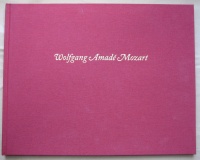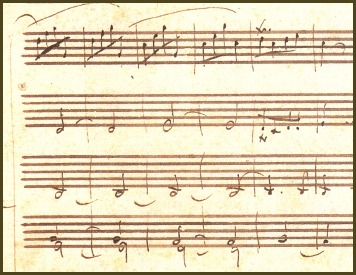Concerto for Horn and Orchestra
in E-flat major, K.370b + 371.


to the Concert Rondeau K.371
Oblong 4˚, 66 pp. (36 color facs), clothbound.
Limited edition of 450 copies. Price: $125
|
| Wolfgang
Amadé Mozart Concerto for Horn and Orchestra in E-flat major, K.370b + 371. A
Facsimile Reconstruction of the Autograph Sources. With a Foreword by
John Brooks Howard and Introductory Essays by Christoph Wolff and
Robert D. Levin. Issued on the Occasion of the 85th Birthday (May 2,
1997) of Dr. Eric Offenbacher.  |
|  detail
from the rediscovered bifolio to the Concert Rondeau K.371Cambridge:
Harvard College Library, 1997. Oblong 4˚, 66 pp. (36 color facs), clothbound. Limited edition of 450 copies. Price: $125 |
|
| OMI
is the sole distributor of the facsimile edition Mozart:
Horn Concerto K. 370b + 371 by
the Harvard College Music Library. This fascinating work, possibly
commissioned for the Viennese hornist Jacob Eisen, is one of a number
of incomplete concerti left by Mozart and one that suffered an
unfortunate circumstance. In 1856, for the centennial of Mozart's
birth, the composer's eldest son, Carl, decided to cut up and give away
portions of the autograph (first movement) as souvenirs to several
admirers of his father's music. Now, more than a 140 years after Carl's
strange celebration, eight of a total of nine fragments are preserved
in seven libraries, six in Europe and one in the US. This facsimile commemorates not only the establishment at Harvard University of the Biblioteca Mozartiana Eric Offenbacher (BMEO) but two important reunifications of the concerto's parts. The first one, assembles and reproduces the scattered autograph fragments of the first movement (K.370b) noted above. The collection of Dr. Offenbacher, donated by him to Harvard, has among its treasures one of these fragments. He had always considered the possibility of bringing them together for an exhibition. This publication has realized that wish by presenting all the surviving fragments which form a substantial portion of the first movement, including an uninterrupted draft score of its first 131 measures. For the second reunification we have to be thankful to Mr. Robert Owen Lehman who has made it possible to present the autograph score of the second movement (K.371) in its entirety. This movement entitled "Rondeau" by Mozart was, until recently, known in a misleading incomplete form and performed in a mutilated version for over half a century. The MS lacked a bifolio that reappeared in 1988. Mr. Lehman, who owns K.371, acquired this bifolio, miraculously completing, after nearly two centuries, this score. These extraordinary events make this publication an invaluable contribution to Mozart studies and highlight one the prime purposes and advantages of the facsimile edition: to have at one's disposal, and side by side, primary sources located thousands of miles apart. "...Mozart's
draft of K.371 appeared in 1882 within the Breitkopf & Härtel Gesamtausgabe. A
completion for horn and piano by Henri Kling was published in 1909, and
an orchestral completion by Bernhard Paumgartner was issued in 1937.
All editions prior to 1993, with or without completion, presented a
movement 219 measures long. It is utterly remarkable that the glaring
structural gap between mm.26 and 27 of the traditional numbering was
never the object of commentary—all the more so given the apperance of
the number "279" at the end of the manuscript.... It was only in 1988
that a hitherto unknown bifolium in Mozart's hand surfaced. At that
time Alan Tyson examined it and realized that it belonged to K.371; its
length, sixty measures, explained the "279" at the end of the
manuscript.... At a time when manuscripts have been dismembered with
their components scattered around the world, it is extraordinarily
fortunate that Robert Owen Lehman, owner of K.371, was able to acquire
the missing bifolium in 1989, reuniting the manuscript after nearly two
centuries. The symbolic reconstitution of the two movements of the
concerto with the present edition was inspired by his example." (Robert
D. Levin, pp. 20-21) OMI
- Old Manuscripts & Incunabula PO Box 6019 FDR Station, New York NY
10150 |